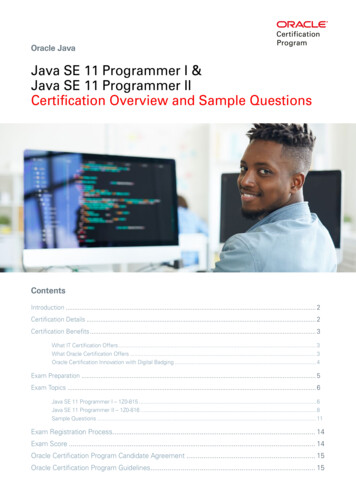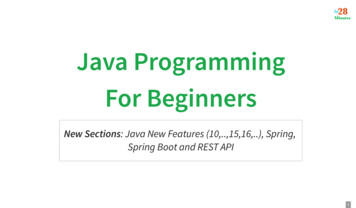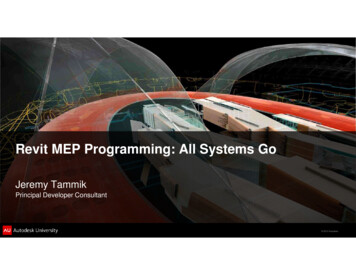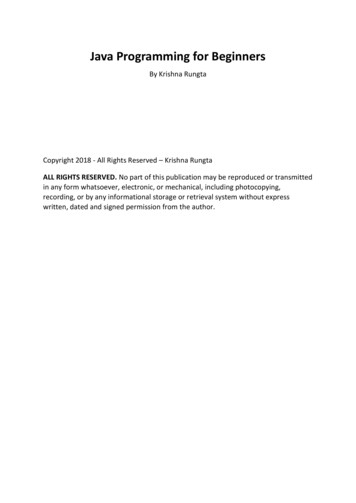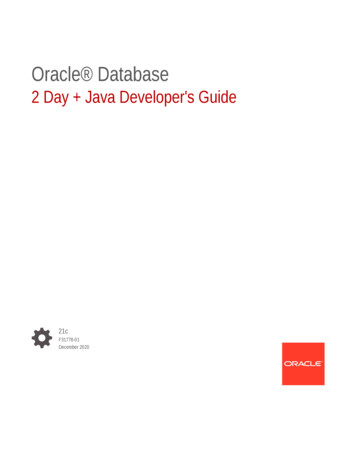
Transcription
Oracle Database2 Day Java Developer's Guide21cF31778-01December 2020
Oracle Database 2 Day Java Developer's Guide, 21cF31778-01Copyright 2007, 2020, Oracle and/or its affiliates.Contributors: Apoorva SrinivasContributing Authors: Tanmay ChoudhuryPrimary Author: Tulika DasContributors: Kuassi Mensah, Nirmala SundarappaThis software and related documentation are provided under a license agreement containing restrictions onuse and disclosure and are protected by intellectual property laws. Except as expressly permitted in yourlicense agreement or allowed by law, you may not use, copy, reproduce, translate, broadcast, modify, license,transmit, distribute, exhibit, perform, publish, or display any part, in any form, or by any means. Reverseengineering, disassembly, or decompilation of this software, unless required by law for interoperability, isprohibited.The information contained herein is subject to change without notice and is not warranted to be error-free. Ifyou find any errors, please report them to us in writing.If this is software or related documentation that is delivered to the U.S. Government or anyone licensing it onbehalf of the U.S. Government, then the following notice is applicable:U.S. GOVERNMENT END USERS: Oracle programs (including any operating system, integrated software,any programs embedded, installed or activated on delivered hardware, and modifications of such programs)and Oracle computer documentation or other Oracle data delivered to or accessed by U.S. Governmentend users are "commercial computer software" or "commercial computer software documentation" pursuantto the applicable Federal Acquisition Regulation and agency-specific supplemental regulations. As such,the use, reproduction, duplication, release, display, disclosure, modification, preparation of derivative works,and/or adaptation of i) Oracle programs (including any operating system, integrated software, any programsembedded, installed or activated on delivered hardware, and modifications of such programs), ii) Oraclecomputer documentation and/or iii) other Oracle data, is subject to the rights and limitations specified in thelicense contained in the applicable contract. The terms governing the U.S. Government’s use of Oracle cloudservices are defined by the applicable contract for such services. No other rights are granted to the U.S.Government.This software or hardware is developed for general use in a variety of information management applications.It is not developed or intended for use in any inherently dangerous applications, including applications thatmay create a risk of personal injury. If you use this software or hardware in dangerous applications, then youshall be responsible to take all appropriate fail-safe, backup, redundancy, and other measures to ensure itssafe use. Oracle Corporation and its affiliates disclaim any liability for any damages caused by use of thissoftware or hardware in dangerous applications.Oracle and Java are registered trademarks of Oracle and/or its affiliates. Other names may be trademarks oftheir respective owners.Intel and Intel Inside are trademarks or registered trademarks of Intel Corporation. All SPARC trademarks areused under license and are trademarks or registered trademarks of SPARC International, Inc. AMD, Epyc,and the AMD logo are trademarks or registered trademarks of Advanced Micro Devices. UNIX is a registeredtrademark of The Open Group.This software or hardware and documentation may provide access to or information about content, products,and services from third parties. Oracle Corporation and its affiliates are not responsible for and expresslydisclaim all warranties of any kind with respect to third-party content, products, and services unless otherwiseset forth in an applicable agreement between you and Oracle. Oracle Corporation and its affiliates will notbe responsible for any loss, costs, or damages incurred due to your access to or use of third-party content,products, or services, except as set forth in an applicable agreement between you and Oracle.
ContentsPreface123AudienceviiRelated DocumentsviiConventionsviiAims and Objectives of This Book1.1Architecture of the HR Web Application1-11.2Components and Repositories1-21.3Objectives and Tasks1-3Brief Introduction to JDBC, UCP, and Java in the Database2.1Java Database Connectivity Driver (JDBC)2-12.2Universal Connection Pool2-22.3Java in the Database (OJVM)2-3Overview of the HR Web Application3.14Functionalities of the HR Web Application3-1Getting Started with the Application4.1What You Need to Install4-14.1.1Oracle Database4-14.1.2Install the HR schema4-24.1.3J2SE or JDK4-24.1.4JDBC Drivers4-24.1.5Integrated Development Environment4-34.1.6Web Server4-34.2Verifying the Oracle Database Installation4-34.3Github Repository Details4-44.4Import the Application in IntelliJ4-4iii
567894.5Compile the Application in IntelliJ4-54.6Run the HR Web Application4-9List All Employees5.1Creating a Java Bean Entity for an Employee5-25.2Creating a Java Bean Interface for a JDBC Connection5-35.3Creating a Java Bean Implementation for a JDBC Connection5-35.4Creating a Servlet to Process the Request5-55.5Create an HTML Page to Display Results5-85.6Create a CSS File5-10Search by Employee ID6.1Jdbc Java Bean6-16.2Add the code to a Servlet to process the request6-26.3Create a New HTML for Search by Employee Id6-3Update an Employee Record7.1Declare a new method getEmployeeByFn(String) in EmployeeBean.java7-17.2Declare a new method updateEmployee(Employee)7-27.3Implement a New Method getEmployeebyFn() for Search by Employee name7-27.4Implement a new method updateEmployee(Employee)7-37.5Add the code to a Servlet to process the request7-47.6Create a New HTML for Search by Employee Id7-5Increment Salary8.1Declare a new method incrementSalary(int)8-18.2Implement a new method incrementSalary(int)8-28.3Add the Code to a Servlet8-28.4Create a new HTML for Increment Salary8-3Create Login and Logout Functionality9.1Create tomcat-users.xml9-29.2Create login.html9-29.3Create login-failed.html9-39.4Create web.xml9-49.5Create about.html9-59.6Create index.html9-5iv
9.7Add the code to a Servlet to process the request10Best Practices11Troubleshooting and Debugging9-7Indexv
List of Tables1-1Architecture of the Web Application1-21-2Components Required for the Application1-24-1Github Repository Details4-4vi
PrefaceThis preface discusses the intended audience and conventions of the OracleDatabase 2 Day Java Developer's Guide. It also includes a list of related Oracledocuments that you can refer to for more information.AudienceThis guide is intended for application developers using Java to access and modifydata in Oracle Database. This guide illustrates how to perform these tasks using asimple Java Database Connectivity (JDBC) application. This guide uses the OracleJDeveloper integrated development environment (IDE) to create the application. Thisguide can be read by anyone with an interest in Java programming, but it assumes atleast some prior knowledge of the following: Java Oracle PL/SQL Oracle databasesRelated DocumentsFor more information, see the following documents in the Oracle Databasedocumentation set: Oracle Database JDBC Developer’s Guide Oracle Database Java Developer’s Guide Oracle Universal Connection Pool Developer’s GuideConventionsThe following text conventions are used in this document:ConventionMeaningboldfaceBoldface type indicates graphical user interface elements associatedwith an action, or terms defined in text or the glossary.italicItalic type indicates book titles, emphasis, or placeholder variables forwhich you supply particular values.monospaceMonospace type indicates commands within a paragraph, URLs, codein examples, text that appears on the screen, or text that you enter.vii
1Aims and Objectives of This BookJava is a popular language among developers that is used to build various enterprisesolutions.This guide will help you understand all Java products used to build a Java application.You will learn how to model a Java Web application using MVC design pattern, OracleJDBC Thin driver, Universal Connection Pool (UCP), and Java in the Database ( usingembedded OJVM).In the next few chapters, you will create a Java web application — ‘HR Webapplication’. This application helps the HR team of AnyCo Corporation to lookup ormodify details of a specific employee, or all employees, delete an employee, or apply asalary raise to all employees.The HR application has two users: hrstaff hradminEach user has a different set of roles and privileges.This Chapter contains the following topics: Architecture of the Web Application Components of the Application Objectives and Tasks1.1 Architecture of the HR Web ApplicationThe HR Web application uses the MVC (Model, View, Controller) architecture and thelatest tools and technologies. A Model View Controllder (MVC) is a design pattern thatis easy-to-use. It separates the web application into three simple parts (Model-ViewController).The Model stores the data or the information that the web application is meant tooperate on. It does not include any information about the user-interface.The View contains all elements of the user interface (UI). This includes buttons,display box, links, input box etc.The Controller connects Model and View.As a user, you will see the interface (View) that could be a JSP page to an HTML pageafter you log into the application. The Controller (a Java Servlet) renders the correctView to the user during logging in, or any other flow. When you request for data or anupdate to the data, the Controller invokes the Model that represents the data in termsof tables or views, and renders the data. The Model represents the user data usuallystored in an Oracle Database or any other database.1-1
Chapter 1Components and RepositoriesThe Controller then passes on this data to the View to show it to the user in apresentable format.Figure 1-1Pictorial Depiction of the Web ApplicationJava EE ContainerPresentationLayerBusiness andData serBrowserHTTPrequest(GET, POST)WebController(Servlet)OracleDatabaseJava Servlet(JDbcBeanImpl)JSONresponsesJDBC, UCPConnectionThe following table describes the various components of the application:Table 1-1Architecture of the Web ApplicationNameTechnologies UsedDescriptionModelOracle Database, Java BeansRepresents the informationor the data on which theapplication operates.ViewHTML, JavaScript, JQuery,CSSUser interface that rendersthe model to the end user. Itincludes all elements visibleto the user such as buttons,links, input, etc.ControllerJava ServletThe controller processes andresponds to user actions. Itorchestrates the flow based onuser input. It also connectsModel and View and rendersan output to the user.You will use HR schema and the Employees to understand the flows in the Webapplication.1.2 Components and RepositoriesThe following table lists and describes all the components required for the application.Table 1-2Components Required for the ApplicationPackage NameDescriptionsrcContains source files1-2
Chapter 1Objectives and TasksTable 1-2(Cont.) Components Required for the ApplicationPackage NameDescriptiontargetContains class dbcBean.javaDefines the employee details as attributes/bean/JdbcBeanImpl.javaImplementation class of the entity/Employee.javaConsists of all employee attributes and theirdefined datatypes/web/WebController.javaServlet that controls the application flow/web/GetRole.javaCreates HRStaff and HRAdmin roles for Java class to be invoked from Java in thedatabase to process an increment in salarySalaryHikeSP.sqlSQL file with a procedure to increase thesalary of the employees based on their salaryrangesrc/main/webapp-about.htmlContains the details about the HR Webapplicationlogin.htmlContains the login page for the HR Webapplicationlogin-failed.htmlPage to show when the login is unsuccessfulindex.htmlLanding page of the HR Web applicationlistAll.htmlHTML page to display all employee recordslistByName.htmlHTML page to display the result whenemployees are searched by namelistById.htmlHTML page to display the result whenemployees are searched by employee idincrementSalary.htmlHTML page to display the result after anincrement is made to the salarysrc/main/webapp-css/app.csContains all style and font details used in theHR Web er for the HR Web application1.3 Objectives and TasksBy the end of this book, you will be able to:a. Understand the JDBC, UCP, Java in the database and run a simple Java program toget familiar with these products.c. You will learn how to use Universal Connection Pool (UCP) and Java in theDatabase (OJVM).b. Implement the functionality to list all employees, search and retrieve an employeeand update an employee record.1-3
Chapter 1Objectives and TasksAn overview of each chapter is described as follows:1.Introduction to JDBC, UCP and Java in the Database: This chapter familiarizesyou with the products, associated binaries and packages through a sample code.2.Overview of the HR Web Application: This chapter discusses the HR Webapplication in depth and familiarize you with the flows of the Web application,packages and files that you create as a part of the web application.3.Getting Started with the Application: In this chapter, you understand theprerequisites for building the application and how to get the environment ready.It starts with signing up for the Oracle Cloud Free Tier or installing the OracleDatabase on premise. Later, you install IntelliJ, an IDE to build the application. Youuse Tomcat Java EE container to deploy and run the application.The chapter also helps you download any other tools, such as Maven, that helpsyou to build the application.4.List All Employees: This chapter helps you to put all the components togetherand build an initial functionality to connect to the Oracle Database, and retrieveemployee details from the database.5.Search By Employee ID: This chapter provides details on how to implement the‘Search by Employee ID’ functionality.6.Update an Employee Record: In this chapter, you learn how to update employeerecords. This is a two step process. Firstly, you search the employee’s records,based on first name. Once you retrieve the required results, you can update thesalary, job ID, firstname, lastname and other details.7.Delete an Employee Record: In this chapter, you learn how to delete anemployee record, in a two-step process.8.Increase Salary to All Employees: In this chapter, you understand how toprovide an increment to the salary of the employees listed in the table, using ‘Javain the database’.9.Creating Application Users: This chapter shows how to create ‘hradmin’ and‘hrstaff’ users in Tomcat and IntelliJ.10. Summary: This chapter summarizes all that you have learnt so far. It alsoprovides appropriate references and links for enhancing your use of the webapplication.1-4
2Brief Introduction to JDBC, UCP, and Javain the DatabaseThe Oracle Database is a relational database that you can use to store, modify anduse data.The Java Database Connectivity (JDBC) standard is used by Java applications toaccess and manipulate data in relational databases.JDBC is an industry-standard application programming interface (API) that letsyou access a RDBMS using SQL from Java. Each vendor implements the JDBCSpecification with its own extensions.Maven is a build automation tool which is used to build and manage the Java project.Universal Connection Pool (UCP) is a cache of database connection objects thatpromote reuse of the connections, thus improving the performance.Java in the Database (OJVM) helps group SQL operations with Java data logic andload them into the database for in-place processing.This chapter introduces you to the JDBC driver, Universal Connection Pool (UCP),Java in the Database (OJVM) and Maven with the Oracle Database. Java Database Connectivity Driver (JDBC) Universal Connection Pool (UCP) Java in the Database (Oracle JVM) Maven2.1 Java Database Connectivity Driver (JDBC)JDBC is a database access protocol that enables you to connect to a database andrun SQL statements and queries on the database.JDBC drivers implement and comply with the latest JDBC specifications. Javaapplications need to have ojdbc8.jar compatible with JDK8 in their classpath.This guide uses the following JDBC standard: Oracle JDBC Thin Driver Oracle JDBC PackagesOracle JDBC Thin DriverOracle recommends using the JDBC Thin Driver for most requirements. The JDBCThin Driver will work on any system with a suitable Java Virtual Machine. (JVM). Someother client drivers that Oracle provides are JDBC thin driver, Oracle Call Interface(OCI) driver, server side thin driver, and server side internal driver.2-1
Chapter 2Universal Connection PoolThe JDBC Thin Driver is a pure Java, Type IV driver. The JDBC driver version(ojdbc8.jar) includes support for JDK 8.JDBC Thin Driver communicates with the server using SQL*Net to access thedatabase.See Also:Oracle Database JDBC Developer’s GuideOracle JDBC PackagesThe following core Java class libraries provide the JDBC APIs: java.sql javax.sqlInclude the import statements at the beginning of your program to import the classeswhich your application needs.Using Maven CentralAll supported releases of the Oracle JDBC drivers are available on Maven Central. So,you can consider Maven Central as a distribution center for the Oracle JDBC driversand companion JAR files.See Also:Maven Central Guide2.2 Universal Connection PoolConnection pools help improve performance by reusing connection objects andreducing the number of times that connection objects are created.Oracle Universal Connection Pool (UCP) is a feature rich Java connection pool thatprovides connection pool functionalities, along with high availability, scalability andload balancing with the help of tighter integration with Oracle Database configurations.A Java application or container must have ucp.jar in their classpath, along with theojdbc8.jar (JDK8), to be able to use UCP.See Also:Oracle Universal Connection Pool Developer’s Guide2-2
Chapter 2Java in the Database (OJVM)2.3 Java in the Database (OJVM)Oracle Database has a Java Virtual Machine (JVM) that resides in the server. It helpsJava applications running in the Oracle JVM on the server to access data present onthe same system and same process.Java in the Database is recommended for applications that are data-intensive. JVMhas the ability to use the underlying Oracle RDBMS libraries directly, without the useof a network connection between the Java code and SQL data. This helps improveperformance and execution. For data access, Oracle Database uses server-sideinternal driver when Java code runs on the server.2-3
3Overview of the HR Web ApplicationThe HR Web Application is intended to give you access to information related to allemployees of AnyCo Corporation.The two types of users that will be able to access this application are: HRStaff HRAdminThe HRStaff and HRAdmin accounts have different privileges.HRStaff has read only access to the application and does not have privileges toupdate/delete an employee record. HRStaff can only List the employees and Searchby Employee ID.The HRAdmin, has complete control on the application and has read and writeprivileges. HRAdmin is the only user who has access to all functionalities of theapplication such as update/delete an employee record, or provide salary increment forall employees.This chapter has the following sections: Functionalities of the HR Web Application Packages3.1 Functionalities of the HR Web ApplicationFollowing is a list of functionalities to access information related to AnyCo Corporation:Through the hrstaff, you can perform the following functions: List All EmployeesUse the List All Employees option to retrieve employee information. Thisfunction lists information such as Employee ID, First Name, Last Name, Email,Phone Number, Job Id, and Salary. Search By Employee IDUse the Employee ID which is the primary key to search for a particular employee.Through the hradmin user, you can perform the following functions:The hradmin user has full control of the application and has both read and updateprivileges. Update Employee RecordYou can update employee records, using the Update Employee Record function.First, search for employees, based on the name of the employee. You can thenupdate employee details in the record, such as first name, last name, email,phone number, job id and salary using the UPDATE function.3-1
Chapter 3Functionalities of the HR Web ApplicationUse the DELETE function to the delete the entire employee record from thedatabase. Increment SalaryThrough the increment salary tab, you can alter (increase or decrease) thepercentage of salary for hike. AboutThis page provides an overview of the HR Application and explains the variousfunctionalities it offers.3-2
4Getting Started with the ApplicationTo develop a Java application that connects to the Oracle Database, you must ensurethat certain components are installed as required.This chapter covers the following topics: What You Need to Install Verifying the Oracle Database 21c Installation4.1 What You Need to InstallTo develop the sample application, you need to install the following products andcomponents: Oracle Database J2SE or JDK Apache Maven IntelliJ Apache Tomcat4.1.1 Oracle DatabaseTo develop the Java web application, you need a working installation of OracleDatabase along with the HR schema. There are two ways you can install the OracleDatabase.Option 1. Oracle Autonomous DatabaseThe Oracle Database Cloud Services offer access to Oracle Cloud Free Tier whichprovides services of two Autonomous Databases for an unlimited time. OracleAutonomous Database is an all-in-one cloud database solution for data marts, datalakes, operational reporting, and batch data processing. Oracle uses machine learningto completely automate all routine database tasks—ensuring higher performance,reliability, security, and operational efficiency. You can get access to a workingAutonomous Database in just a few minutes. After signing up, you will have accessto your choice of Autonomous Transaction Processing or Autonomous DataWarehouse databases.We will be using Autonomous Transaction Processing to run the HR Application.Note:Refer to Provisioning an ATP Database instance video for instructions.Option 2: Oracle Database Express Edition (XE) Available on OTN4-1
Chapter 4What You Need to InstallAs an alternate option, you can install Oracle Database Express Edition (XE) onpremise.Note:The Quick Start guide provides instructions on how to download and installthe Oracle Database Express Edition (XE) on your machine.4.1.2 Install the HR schemaThe HR web application uses the tables and data from the HR sample schemaprovided by Oracle. You need to install the HR schema in your database.Once you provision your Autonomous Database or install Oracle Databse XE, seeInstalling HR Schema for detailed instructions to install the sample schema.4.1.3 J2SE or JDKTo create and compile Java applications, you need the full Java 2 Platform,Standard Edition, Software Development Kit (J2SE SDK), formerly known as the JavaDevelopment Kit (JDK).1.Download and install the Java SE. Refer loads/index.html.2.Set the PATH environment variable for JDK. Refer JDK Installation Instructions forWindows for detailed instructions.4.1.4 JDBC DriversYou need to download certain JDBC drivers for running the HR application.This guide uses Maven Central to download the necessary JDBC drivers required forthe application. Later in this guide, you learn to add the following dependency to yourproject's pom.xml file: dependencies dependency groupId com.oracle.database.jdbc groupId artifactId ojdbc8-production /artifactId version 19.7.0.0 /version type pom /type /dependency /dependencies The ojdbc8-production pulls all the required JDBC jars from the Maven CentralRepository. For more information, see the Maven Central Guide.4-2
Chapter 4Verifying the Oracle Database Installation4.1.5 Integrated Development EnvironmentFor ease in developing the application, you can choose to develop your application inan integrated development environment (IDE). This guide uses IntelliJ Idea communityversion to create and update the files for this application.Note:To download and install IntelliJ Idea, see https://www.jetbrains.com/idea/.4.1.6 Web ServerThe sample application developed in this guide uses JavaServer Pages (JSP)technology to display information and accept input from users. To deploy these pages,you need a Web server with a servlet and JSP container.This guide uses the Apache Tomcat server for deploying the JSP pages.For more information on how to download and install Apache Tomcat, refer to http://tomcat.apache.org/.4.2 Verifying the Oracle Database InstallationOracle Database installation is platform-specific. You must verify that the installationwas successful before you proceed to create the sample application.Verify the Oracle Database XE Installation1.Verify the Oracle Database XE installation by connecting to the database.2.From the command prompt, connect to sqlplus. sqlplus system/ password @xepdb1SQL*Plus: Release 18.0.0.0.0 - Production on Wed Sep 9 16:01:34 2020Version 18.4.0.0.0Copyright (c) 1982, 2018, Oracle.All rights reserved.Connected to:Oracle Database 18c Express Edition Release 18.0.0.0.0 - ProductionVersion 18.4.0.0.0SQL 3.As an optional step, you can run a sample Java application with Oracle Databaseusing JDBC. See Quick Start with JDBC.Verify connecting to Oracle ATP InstanceOnce you provision an ATP instance, verify the connection as follows:4-3
Chapter 4Github Repository Details1.Download the Client Credentials. Login to your database instance and click on theDB Connection tab. Select Instance Wallet for Wallet type and click DownloadWallet. Unzip the file to a secure directory on your local machine.2.Follow instructions provided in the Java Connectivity with Autonomous Databaseto connect using JDBC and UCP code samples.4.3 Github Repository DetailsThe source files for the HR Web Application is available on GitHub.Table 4-1Github Repository DetailsName and LocationDetailsHRWebAppThis repository contains the complete codesamples of the application.4.4 Import the Application in IntelliJImport the application in IntelliJ as follows:1.Open IntelliJ and select Open or Import.4-4
Chapter 4Compile the Application in IntelliJ2.Navigate to the location where the HRWebApp is downloaded. Select HRWebAppand click OK.3.A project with all the files required to build the HR Web application is displayed.4.5 Compile the Application in IntelliJThe HR Web Application easily compiles using Maven in IntelliJ.The code requires a few updates before you compile the application.The HRWebApp must be downloaded and opened in IntelliJ.1.In the Project window on the left, double-click on pom.xml file.4-5
Chapter 4Compile the Application in IntelliJ2.Add the following dependency under the dependencies tag in pom.xml file. SeeJDBC Drivers for more information.3.In the Project window, expand the src folder, expand main and then Java folder.Under Java, expand com.oracle.jdbc.samples. In the bean folder, double-clickJdbcBeanImpl.4-6
Chapter 4Compile the Application in IntelliJ4.Update the connection variable with the details of your database connection. Forexample, to connect to the HR schema on the Oracle XE database instancexepdb1 with port 1522 on your machine, edit the url parameter as follows:Connection connection alhost:1522/xepdb1", "hr", "hr");5.In the File menu, select Save All to save the changes.4-7
Chapter 4Compile the Application in IntelliJ6.In the Maven window on the right, double-click on clean to clean thesource code. The build progress is shown in the Run window at thebottom.7.Similarly, double-click on compile and package in the same order.8.Once the source code is packaged successfully, a war file is generated. Locate theJdbcWebSamples.war under the target folder.4-8
Chapter 4Run the HR Web Application4.6 Run the HR Web ApplicationThe HR Web application is run using the Tomcat server.Deploy the .war file on the Apache server1.Navigate to the HRWebApp folder on your local machine. Under the target folder,locate JdbcWebSamples.war file.2.Place JdbcWebSamples.war file under TOMCAT HOME/webapps/.3.Navigate to the HRWebApp folder on your local machine. Locate tomcatusers.xml file.4.Place tomcat-users.xml file under TOMCAT HOME/conf/.5.Start the tomcat server.6.Once the tomcat is started, access the HR web application from a browser usingthe URL http://localhost:8080/JdbcWebSamples/.Verify the HR Web Application1.Login to the application with either hradmin or hrstaff user.4-9
Chapter 4Run the HR Web ApplicationNote: For more information about the hradmin and hrstaff users, seeOverview of the HR Web Application and Create Login and LogoutFunctionality. Refer tomcat-users.xml file for the username and passwordinformation required to login to the HR Web Application.2.HR Web Application has several functionalities. List All displays the employees'details such as Employee id, First name, Last Name, Email, Phone number,Job id, Salary etc. The details are retrieved from the Employees table anddisplayed on a web page. See the screenshot below that shows List Allfunctionality.3.Similarly, verify the remaining functionalities such as Search by ID, UpdateEmployee Record and Increment Salary by giving appropriate inputs.4-10
5List All EmployeesThe HR web Application has several
Java is a popular language among developers that is used to build various enterprise solutions. This guide will help you understand all Java products used to build a Java application. You will learn how to model a Java Web application using MVC design pattern, Oracle JDBC Thin driver, Universal Connection


![Welcome [dashdiet.me]](/img/17/30-day-weight-loss-journal.jpg)


